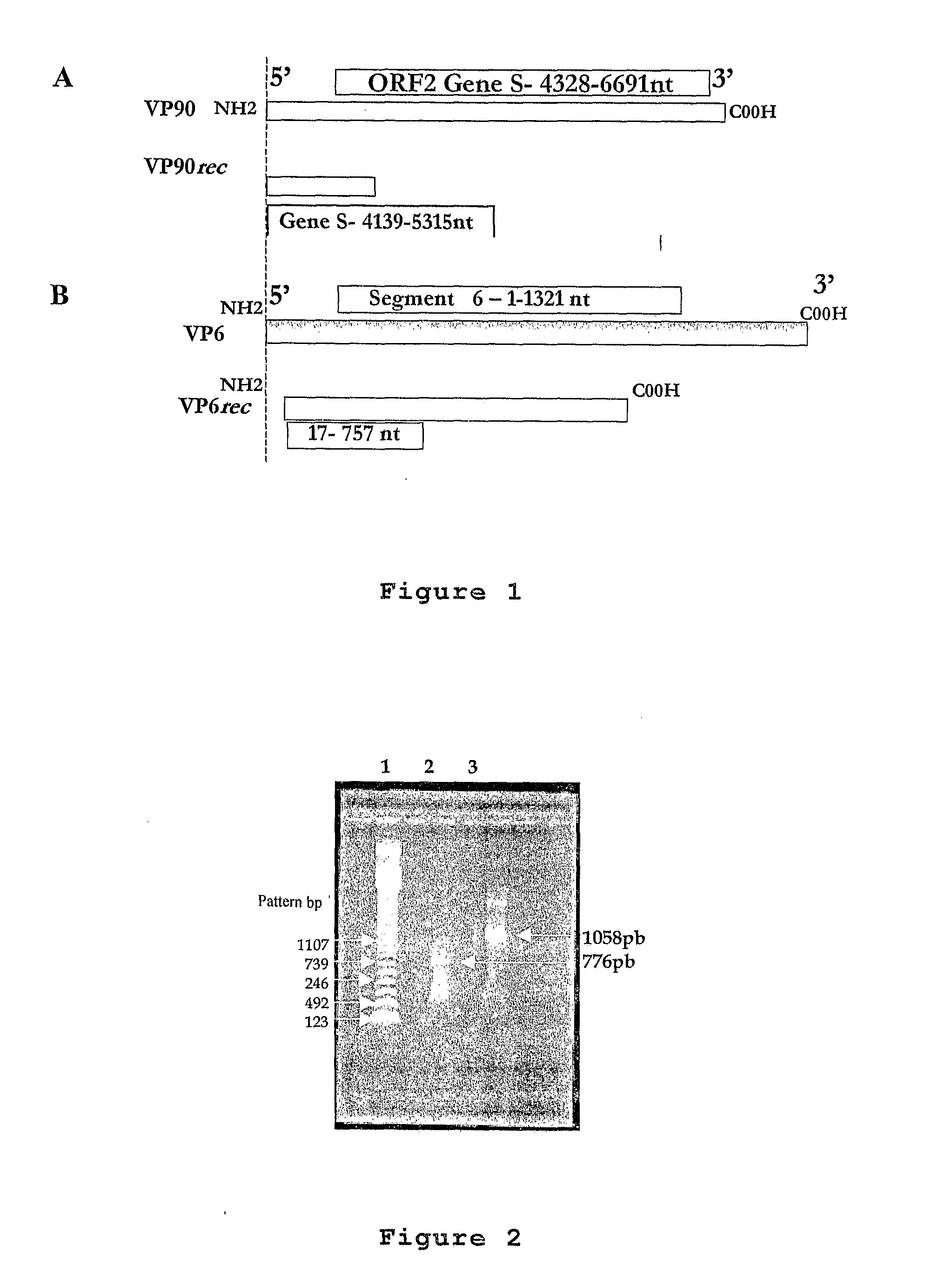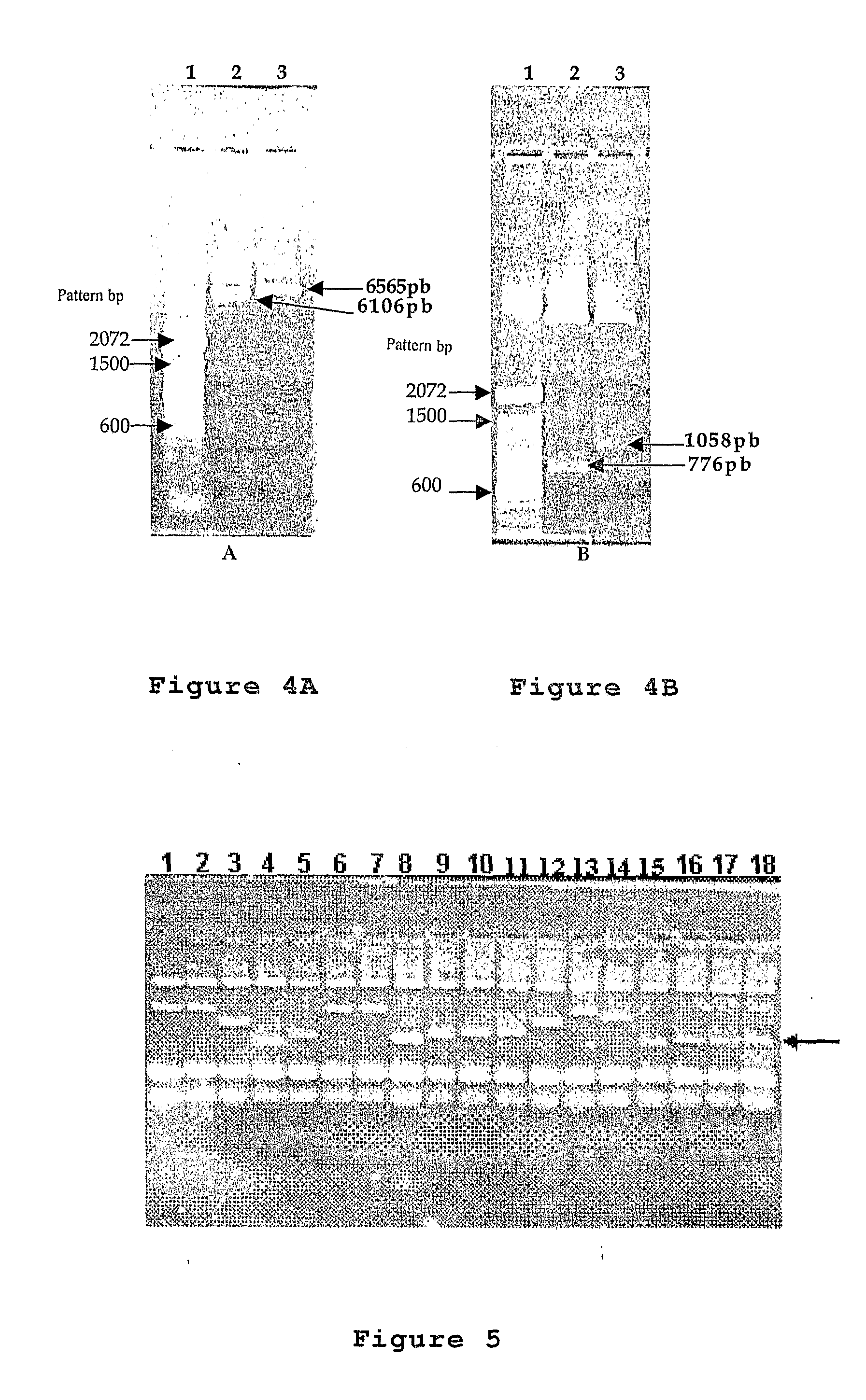Plasmid Expression Vectors for Expression of Recombinant Rotavirus and Astrovirus Proteins or Epitopes
a technology of astrovirus and astrovirus, which is applied in the field of plasmid expression vectors for the expression of recombinant rotavirus and astrovirus proteins or epitopes, can solve the problems of rotavirus infection asymptomatic, universal hygiene practices such as hand washing, water and food quality control, and adequa
- Summary
- Abstract
- Description
- Claims
- Application Information
AI Technical Summary
Benefits of technology
Problems solved by technology
Method used
Image
Examples
example 1
Obtainment of pOM187 Vectors for Rotavirus and pOM186 for Astrovirus
[0065]RNA pattern molecules were extracted from fecal positive samples for the viruses caused by rotavirus and by astrovirus, through an appropriate commercial kit. The RNA pattern molecules were used for obtaining the cDNA.
[0066]In the present invention, for the obtainment of the cDNA, a selection of starting oligonucleotides sequences, which are organized in Table 1, was performed. This cDNA was obtained through transcriptase reverse reaction.
[0067]FIG. 1 shows the localization of the nucleotide sequences cloned in the virus genoma. The present concretization has as its base the segment 6 of the Wa human RNA rotavirus and ORF2 human type 1 RNA rotavirus.
TABLE 1Starting Oligonucleotides used for the syn-thesis of cDNA, in the amplification reactionby RT-PCRGenomalocaliza-StarterstionSequence (5′-3′)Positive17-42CTTCgCCATggAggTTCTgTACTCACrotavirusNegative730-757gTCgCgCCATCggCCgAATTAATTACTCrotavirusPositive4139-4164A...
example 2
Bacterial Transformation and DNA Plasmodial Acquisition with High-Level Purity
[0077]The E. coli bacterial strain was transformed, with the pOM186 and pOM187 expression vectors, through the methodology of electroporation. This electroporation was performed so as to submit the bacterial cells to an electrical discharge of 2500 volts for 5 seconds. In the present concretization the TOP10F′E. coli strain is used. After the discharge, recovery of the bacterial cells was done through the addition to the reaction of approximately 500 μl of an adequate growth medium. In the present concretization, a liquid SOC was used [2% of triptone, 0.5% of yeast extract, 8.6 mM of NaCl, 2.5 mM of KCl, 20 mM of MgSO4 and 20 mM of glucose, pH 7.0]. After the addition of the liquid SOC, the reaction was incubated at 37° C. temperature under agitation (approximately 250 rpm) for approximately an hour.
[0078]After the agitation period, the reaction plaquing was performed in two Petri dishes with 20 ml of an a...
example 3
Characterization of the Plasmodium pOM186 and pOM187 Concretizations
[0082]The final plasmodium constructions were characterized through the enzymatic breaking reaction with PstI / NcoI endonuclease restriction reactions for the VP6 genes of the rotavirus (pOM187) and HindIII / NheI for the VP90 of the astrovirus (pOM186).
[0083]The digestion reactions of the plasmodium DNAs comprehends the following components and steps:[0084]approximately 20 μl of a solution containing 1 μg / μl of the plasmodium constructions pOM187 and pOM186 purified from E. coli TOP10F′ strain,[0085]approximately 1 μl of each one of the restriction enzymes PstI / NcoI (100 / μl each) for the VP6 genes of the rotavirus,[0086]approximately 1 μl of each one of the restriction enzymes HindIII / NheI (10 U / μl each) for the VP90 genes of the astrovirus,[0087]addition of approximately 2.5 μl of a commercial buffer solution recommended for each one of the HindIII / NheI and PstI / NcoI enzymes used, where the mentioned buffer solution ...
PUM
| Property | Measurement | Unit |
|---|---|---|
| temperature | aaaaa | aaaaa |
| concentration | aaaaa | aaaaa |
| pH | aaaaa | aaaaa |
Abstract
Description
Claims
Application Information
 Login to View More
Login to View More - R&D
- Intellectual Property
- Life Sciences
- Materials
- Tech Scout
- Unparalleled Data Quality
- Higher Quality Content
- 60% Fewer Hallucinations
Browse by: Latest US Patents, China's latest patents, Technical Efficacy Thesaurus, Application Domain, Technology Topic, Popular Technical Reports.
© 2025 PatSnap. All rights reserved.Legal|Privacy policy|Modern Slavery Act Transparency Statement|Sitemap|About US| Contact US: help@patsnap.com



